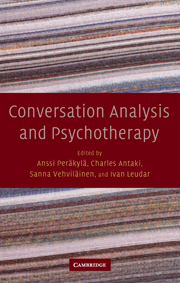Book contents
- Frontmatter
- Contents
- List of illustrations
- List of contributors
- Foreword: Filling the gaps
- 1 Analysing psychotherapy in practice
- 2 Formulations in psychotherapy
- 3 Clients' responses to therapists' reinterpretations
- 4 Lexical substitution as a therapeutic resource
- 5 Resisting optimistic questions in narrative and solution-focused therapies
- 6 Conversation analysis and psychoanalysis: Interpretation, affect, and intersubjectivity
- 7 Identifying and managing resistance in psychoanalytic interaction
- 8 Person reference as a device for constructing experiences as typical in group therapy
- 9 Conversation of emotions: On turning play into psychoanalytic psychotherapy
- 10 A psychotherapist's view of conversation analysis
- 11 A review of conversational practices in psychotherapy
- Transcription notation
- References
- Author index
- Subject index
1 - Analysing psychotherapy in practice
Published online by Cambridge University Press: 22 September 2009
- Frontmatter
- Contents
- List of illustrations
- List of contributors
- Foreword: Filling the gaps
- 1 Analysing psychotherapy in practice
- 2 Formulations in psychotherapy
- 3 Clients' responses to therapists' reinterpretations
- 4 Lexical substitution as a therapeutic resource
- 5 Resisting optimistic questions in narrative and solution-focused therapies
- 6 Conversation analysis and psychoanalysis: Interpretation, affect, and intersubjectivity
- 7 Identifying and managing resistance in psychoanalytic interaction
- 8 Person reference as a device for constructing experiences as typical in group therapy
- 9 Conversation of emotions: On turning play into psychoanalytic psychotherapy
- 10 A psychotherapist's view of conversation analysis
- 11 A review of conversational practices in psychotherapy
- Transcription notation
- References
- Author index
- Subject index
Summary
What are psychotherapies?
The Oxford English Dictionary defines modern psychotherapy as “the treatment of disorders of the mind or personality by psychological or psychophysiological methods.” Administering electroconvulsive shocks would, however, hardly count as psychotherapy; the common assumption is that, in psychotherapies, the means of healing is talk. Not all talk is therapeutic, and the history of psychotherapy involves not just formulating new psychological theories but evolving new and distinct ways of talking with clients. This book is an effort to describe and to understand these distinct ways of talking.
Many psychoanalytic historiographies locate the invention of psychotherapy in Breuer's work with a patient they called Anna O. (described in Freud and Breuer's Studies on Hysteria, 1991/1895) at the end of the nineteenth century. Anna O. found that narrating her worries and fantasies helped to relieve her symptoms and she coined the phrase “the talking cure” to describe what she was doing. Freud used her case retrospectively to document the invention of psychoanalysis, which became the first form of psychotherapy. Rather soon, however, there emerged other ways of doing and thinking about “the talking cure,” and at least since the 1950s, the field of psychotherapy has been characterized by the multitude of (often rival) approaches. In psychotherapy with individual patients, client-centred psychotherapy gained influence in the 1950s (see e.g. Rogers, 1951), and cognitive-behavioural therapies have been increasingly popular since the 1970s (see e.g. Dryden, 2007).
- Type
- Chapter
- Information
- Conversation Analysis and Psychotherapy , pp. 5 - 25Publisher: Cambridge University PressPrint publication year: 2008
- 35
- Cited by

